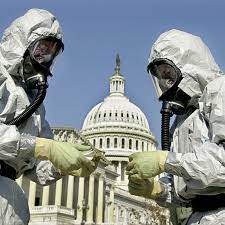Anthrax

2001 was a very challenging and chaotic year. On September 11 the world witnessed the horrible attacks on the Twin Towers causing great pain across America and shocking the globe. Imagine, a week later, seeing on the news that an office worker from Palm Beach County, Florida was exposed to a lethal drug called Anthrax and died shortly after being exposed to it. Imagine the horrible thoughts going through these already anguished and suffering citizens’ heads. What is Anthrax? How can one be exposed to Anthrax and what will it do to me if I am exposed? What about the horrible fear and anxiety that overcomes one’s body having to wonder about the terrifying question–is this yet another terrorist attack?
At this time, New York City was being flooded with Anthrax attacks. NBC reporters were being tested for anthrax and those tests were coming back positive. People left and right were being exposed to this pernicious substance and dying. The end result of the attacks was 5 dead and 17 injured, but the major question everyone was concerned with was, who did it? Who could have it in them to send letters to innocent people knowing how deadly the substance being used was? Netflix released an in depth documentary talking about the victims and how hard the hard process was to catch the attacker. So… who did it?
The Anthrax investigation became one of the largest investigations in U.S history. The FBI agents who were investigating really didn’t have any clue about this drug initially, so they relied on other scientists to help them get a better idea of what Anthrax was, how it functioned, and how it killed. One of the major people involved with this investigation was microbiologist Bruce Edwards Ivan. NBC news assistant Casey Chamberlain was opening mail for a nightly news reporter and saw a weird powdery substance in the letter. In the documentary “Anthrax Attacks” she stated, “The letter had something that looked like a combination of brown sugar and sand.” You could be exposed to anthrax and never know it. How crazy is that?
In August of 2002 there was a break in the case naming the first suspect, Steven Hatfill. Hatfill was a biologist who had a few rough patches through his career. He lost his job in 1999 due to violating lab procedures. He then got a job with the government and was let go from that job as well. Was it possible for Hatfill to be so angry with the government it led him to create Anthrax to harm people as retaliation against the government? Later the FBI would prove that Hatfill would have no connection with the Anthrax, but six years after Hatfill had been named suspect, in 2008, Bruce Edwards Ivan, the very same scientist that was helping the FBI, became very suspicious due to the strange behavior he was expressing during the investigation against Hatfill.
Seven years had passed since the first Anthrax attack and there was still no answer who committed the crimes. Hatfill was finally ruled out as a suspect after finding no evidence of him being around or using the drug. Ivans had been cooperating with the FBI so well. He was also very helpful with sharing the knowledge he had. So why were there still no answers? Maybe Ivans wasn’t as innocent as he seemed. Suspicion started to rise towards Ivans when the FBI noticed how defensive he would get when he would be talked to about the attacks. He almost had a demeanor of, “I swear I didn’t do it” even when no one suspected him.
A picture of Ivans and his colleagues was found in an email message that was titled, “In the lab”. The picture was taken on September 14, 2001, and showed workers looking over petri dishes of Anthrax. That same day dozens of people would be hospitalized and some died due to exposure to Anthrax. Ivans sent another email to a colleague stating, “Bin Laden terrorists for sure have anthrax and sarin gas.” This email sounded similar to the letter sent to the NBC reporter that contained anthrax. That letter said, “We have this Anthrax… death to America… death to Israel.” This letter caused the FBI to be on high alert with not only Ivans, but with his staff as well. Investigators felt like fools considering the person that they thought they were working with was not who he said he was. To prove his guilt, the FBI decided to interview his colleagues and family. It was then when they found out that the suspect was mentally ill and suffered from alcoholism. It was also reported that he would work in the lab at nights often and when confronted about it, he said it was because he had abnormal thoughts. In those emails that were sent to his coworkers he would say things like, “I wish I could control the thoughts in my mind” or “It’s hard enough sometimes controlling my behavior. When I am being eaten alive inside, I always try to put on a good front here at work or home so I don’t spread the pestilence.” Finally a search warrant was granted against the microbiologist.
Nothing significant was found in the home of Bruce Ivans and the bureau started to have doubts if he was actually the Anthrax killer. Bruce Edwards Ivans passed away July 29, 2008 due to suicide. The FBI finally concluded that it was Bruce Ivans that committed the attacks. But the idea of Ivans being innocent is very much a possibility. But that brings us back to our question before… who did it?

